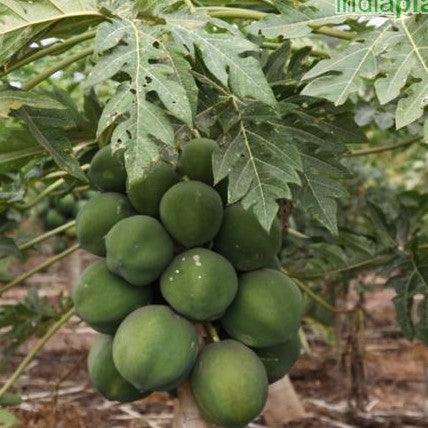
Dwarf Papaya" Taiwan Red Lady" Carica Papaya Sweet Variety Live Plant Fruit Plants For Small Gardens (Healthy Plant)paya Sweet Variety 1 Live Plant Fruit Plants For Small Gardens (Healthy Plant)
Original price
Rs. 99.00
-
Original price
Rs. 99.00
Original price
Rs. 99.00
Rs. 99.00
-
Rs. 99.00
Current price
Rs. 99.00
-
Common name:
- Papaya,
- Red Papaya
- Regional name:
- Marathi - Papai; Hindi - Papeeta; Bengali - Pappaiya; Gujrati - Papayi; Tamil - Pappali; Kannada - Parangi-mara, Malayalam - Omaca, Telugu - Boppayi
- Category:
- Fruit Plants, Trees, Medicinal Plants
- Family:
- Caricaceae
-
Introduction
The Dwarf Papaya "Taiwan Red Lady" tree is a popular variety known for its compact size and delicious fruit. It is well-suited for small gardens or container cultivation, making it a great choice for those with limited space. This guide will cover essential information, plantation, growing, care, and benefits of the Taiwan Red Lady tree.
Information
- Scientific Name: Carica papaya
- Family: Caricaceae
- Origin: Taiwan
- Tree Height: 6-8 feet
- Fruit Color: Orange-red
- Fruit Size: Medium, 1.5-2.5 kg
Plantation
- Location: Choose a sunny location with well-draining soil.
- Spacing: Plant trees 8-10 feet apart to ensure adequate airflow.
- Soil: Opt for a loamy soil with a pH between 6.0-6.5.
- Planting Time: Plant in early spring or late summer, depending on your climate.
Growing
- Watering: Keep the soil consistently moist, but not waterlogged.
- Fertilization: Use a balanced, slow-release fertilizer every 2-3 months.
- Pruning: Remove dead or diseased branches to promote healthy growth.
- Pest Control: Regularly inspect for pests, such as aphids, and treat as necessary.
Care
- Mulching: Apply a 2-3 inch layer of organic mulch to conserve moisture and suppress weeds.
- Staking: Use stakes to support the tree and protect it from strong winds.
- Pollination: Encourage natural pollinators, such as bees, or hand pollinate if necessary.
- Harvesting: Harvest fruit when it turns from green to yellow-orange, usually 9-12 months after planting.
Benefits
- Compact Size: Ideal for small gardens and container cultivation.
- High Yield: Produces an abundance of fruit in a small space.
- Nutritious Fruit: Rich in vitamins A, C, and E, as well as fiber and antioxidants.
- Ornamental Value: Attractive foliage and fruit make it an appealing addition to your landscape.
